Christopher alexander - A pattern language
Здесь есть возможность читать онлайн «Christopher alexander - A pattern language» весь текст электронной книги совершенно бесплатно (целиком полную версию без сокращений). В некоторых случаях можно слушать аудио, скачать через торрент в формате fb2 и присутствует краткое содержание. Жанр: Прочая научная литература, на английском языке. Описание произведения, (предисловие) а так же отзывы посетителей доступны на портале библиотеки ЛибКат.
- Название:A pattern language
- Автор:
- Жанр:
- Год:неизвестен
- ISBN:нет данных
- Рейтинг книги:3 / 5. Голосов: 1
-
Избранное:Добавить в избранное
- Отзывы:
-
Ваша оценка:
- 60
- 1
- 2
- 3
- 4
- 5
A pattern language: краткое содержание, описание и аннотация
Предлагаем к чтению аннотацию, описание, краткое содержание или предисловие (зависит от того, что написал сам автор книги «A pattern language»). Если вы не нашли необходимую информацию о книге — напишите в комментариях, мы постараемся отыскать её.
A pattern language — читать онлайн бесплатно полную книгу (весь текст) целиком
Ниже представлен текст книги, разбитый по страницам. Система сохранения места последней прочитанной страницы, позволяет с удобством читать онлайн бесплатно книгу «A pattern language», без необходимости каждый раз заново искать на чём Вы остановились. Поставьте закладку, и сможете в любой момент перейти на страницу, на которой закончили чтение.
Интервал:
Закладка:
A boundary around an important precinct, whether a neighborhood, a building complex, or some other area, is most critical at those points where paths cross the boundary. If the point where the path crosses the boundary is invisible, then to all intents and purposes the boundary is not there. It will be there, it will be felt, only if the crossing is marked. And essentially, the crossing of a boundary by a path can only be marked by a gateway. That is why all forms of gateway play such an important role in the environment.
A gateway can have many forms: a literal gate, a bridge, a passage between narrowly separated buildings, an avenue of trees, a gateway through a building. All of these have the same function: they mark the point where a path crosses a boundary and help
TOWNS
maintain the boundary. All of them are “things”—not merely holes or gaps, but solid entities.
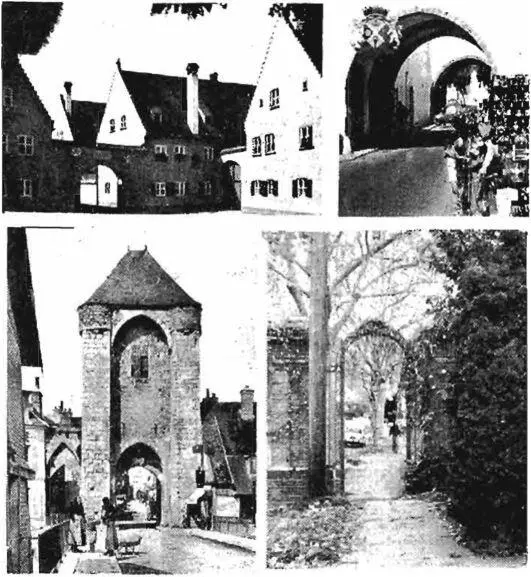 |
| Gateways mark the foint of transition. |
In every case, the crucial feeling which this solid thing must create is the feeling of transition.
Therefore:
Mark every boundary in the city which has important human meaning—the boundary of a building cluster, a neighborhood, a precinct—by great gateways where the major entering paths cross the boundary.
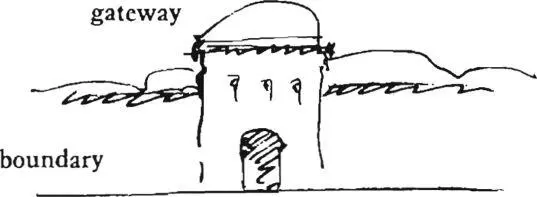
278 53 main gateways
Make the gateways solid elements, visible from every line of approach, enclosing the paths, punching a hole through a building, creating a bridge or a sharp change of level—but above all make them “things,” in just the same way specified for main entrance (iio), but make them larger. Whenever possible, emphasize the feeling of transition for the person passing through the gateway, by allowing change of light, or surface, view, crossing water, a change of level—entrance transition (112). In every case, treat the main gateway as the starting point of the pedestrian circulation inside the precinct—circulation realms (98)* • • •
| 54 road crossing |
|---|
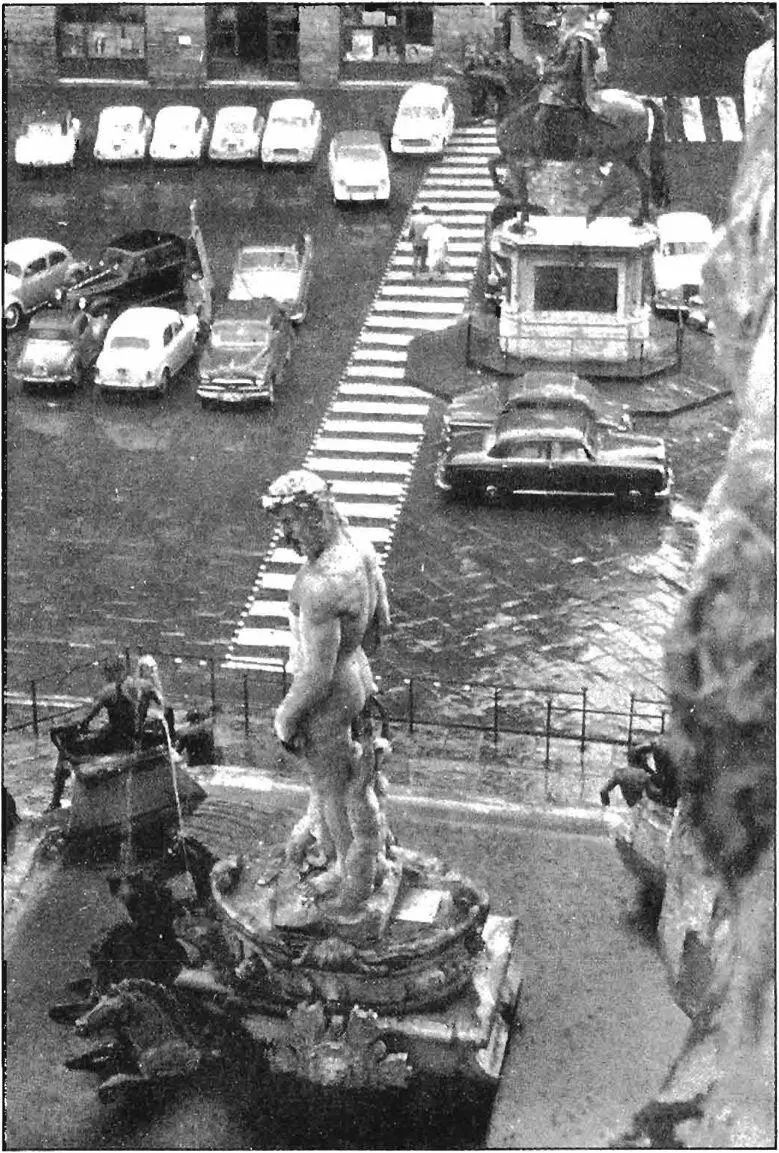 |
| 280 |
. . . under the impetus of parallel roads (23) and network of paths and cars (52), paths will gradually grow at right angles to major roads—not along them as they do now. This is an entirely new kind of situation, and requires an entirely new physical treatment to make it work.
❖ •{♦
Where paths cross roads, the cars have power to frighten and subdue the people walking, even when the people walking have the legal right-of-way.
This will happen whenever the path and the road are at the same level. No amount of painted white lines, crosswalks, traffic lights, button operated signals, ever quite manage to change the fact that a car weighs a ton or more, and will run over any pedestrian, unless the driver brakes. Most often the driver does brake. But everyone knows of enough occasions when brakes have failed, or drivers gone to sleep, to be perpetually wary and afraid.
The people who cross a road will only feel comfortable and safe if the road crossing is a physical obstruction, which physically guarantees that the cars must slow down and give way to pedestrians. In many places it is recognized by law that pedestrians have the right-of-way over automobiles. Yet at the crucial points where paths cross roads, the physical arrangement gives priority to cars. The road is continuous, smooth, and fast, interrupting the pedestrian walkway at the junctions. This continuous road surface actually implies that the car has the right-of-way.
What should crossings be like to accommodate the needs of the pedestrians?
The fact that pedestrians feel less vulnerable to cars when they are about 18 inches above them, is discussed in the next pattern raised walk (55). The same principle applies, even more powerfully, where pedestrians have to cross a road. The pedestrians who cross must be extremely visible from the road. Cars should also be forced to slow down when they approach the crossing. If the pedestrian way crosses 6 to 12 inches above the road-
way, and the roadway slopes up to it, this satisfies both requirements. A slope of I in 6, or less, is safe for cars and solid enough to slow them down. To make the crossing even easier to see from a distance and to give weight to the pedestrian’s right to be there, the pedestrian path could be marked by a canopy at the edge of the road—canvas roofs (244).
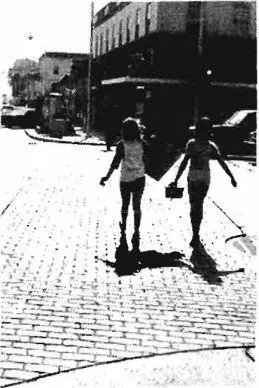 |
| Almost a road crossing . . . but no bumf. |
We know that this pattern is rather extraordinary. For this reason, we consider it quite essential that readers do not try to use it on every road, for formalistic reasons, but only on those roads where it is badly needed. We therefore comolete the problem statement by defining a simple experiment which you can do to decide whether or not a given crossing needs this treatment.
Go to the road in question several times, at different times of day. Each time you go, count the number of seconds you have to wait before you can cross the road. If the average of these waiting times is more than two seconds, then we recommend you use the pattern. (On the basis of Buchanan’s statement that roads become threatening to pedestrians when the volume of traffic on them creates an average delay of two seconds or more, for people trying to cross on foot. See the extensive discussion, Colin Buchanan et ah, Traffic in Towns , HMSO, London, 1963, pp. 203—13.) If you cannot do this experiment, or the road is not yet built, you may be able to guess, by using the chart below. It shows which combinations of volume and width will typically create more than a two-second average delay.
| 54 road crossing |
|---|
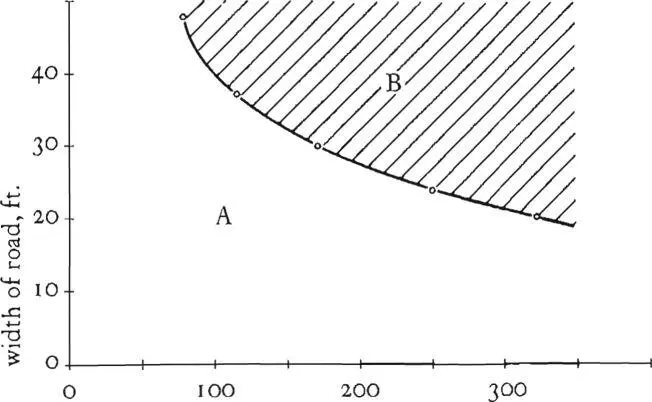 |
| vehicles per hour Roads that fall in the shaded region require sfecial crossings. |
One final note. This pattern may be impossible to implement, in places where traffic engineers are still in control. Nevertheless the functional, issue is vital, and must not be ignored. A big wide road, with several lanes of heavy traffic can form an almost impenetrable barrier. In this case, you can solve the problem, at least partially, by creating islands—certainly one in the middle, and perhaps extra islands, between adjacent lanes. This has a huge effect on a person’s capacity to cross the road, for a very simple reason. If you are trying to cross a wide road, you have to wait for a gap to occur simultaneously in each of the lanes. It is the waiting for this coincidence of gaps that creates the problem. But if you can hop, from island to island, each time a gap occurs in any one lane, one lane at a time, you can get across in no time at all—because the gaps which occur in individual lanes are many many times more frequent, than the big gaps in all lanes at the same time. So, if you can’t raise the crossing, at least use islands, like stepping stones.
Читать дальшеИнтервал:
Закладка:
Похожие книги на «A pattern language»
Представляем Вашему вниманию похожие книги на «A pattern language» списком для выбора. Мы отобрали схожую по названию и смыслу литературу в надежде предоставить читателям больше вариантов отыскать новые, интересные, ещё непрочитанные произведения.
Обсуждение, отзывы о книге «A pattern language» и просто собственные мнения читателей. Оставьте ваши комментарии, напишите, что Вы думаете о произведении, его смысле или главных героях. Укажите что конкретно понравилось, а что нет, и почему Вы так считаете.












